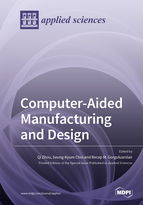Computer-Aided Manufacturing and Design
A special issue of Applied Sciences (ISSN 2076-3417). This special issue belongs to the section "Applied Industrial Technologies".
Deadline for manuscript submissions: closed (30 April 2020) | Viewed by 41735
Special Issue Editors
Interests: additive manufacturing (AM); printing process; advanced materials; computer-aided design; experimental models; certification; characterization
Special Issues, Collections and Topics in MDPI journals
Interests: design for additive manufacturing; lightweight lattice materials; topology optimization; solid mechanics; uncertainty quantification; reliability-based design; multiscale modeling; surrogate modeling
Special Issue Information
Dear Colleagues,
Recent advancements in computer technology have allowed for designers to have direct control over the production process thorugh the help of computer-based tools, creating the possibility of a completely integrated design and manufacturing processes.
Over the last few decades, "artificial intelligence" (AI) techniques such as machine learing and deep learning have been topics of interest in computer-based design and manufacturing research fields. However, efforts to develop computer-based AI to handle big data in design and manufacturing have not yet been successful.
This Special Issue of Applied Sciences aims to collect novel articles covering artifical intelligance-based design, manufacturing, and data-driven design. Topics of interest include, but are not strictly limited to the following:
- The application of artificial intelligence (AI) in Computer Aided Manufacturing and Design;
- The application of deep learning and machine learning techniques for Computer Aided Manufacturing and Design;
- Design under uncertainty;
- Data-driven design;
- Optimal design for manufacturing;
- Comparison analysis among several AI techniques applied to Computer Aided Manufacturing and Design;
- Case studies of the application of AI techniques to mechanical engineering design;
- Design for advanced manufacturing techniques such as additive manufacturing…
Prof. Seung-Kyum Choi
Dr. Recep M. Gorguluarslan
Dr. Qi Zhou
Guest Editors
Manuscript Submission Information
Manuscripts should be submitted online at www.mdpi.com by registering and logging in to this website. Once you are registered, click here to go to the submission form. Manuscripts can be submitted until the deadline. All submissions that pass pre-check are peer-reviewed. Accepted papers will be published continuously in the journal (as soon as accepted) and will be listed together on the special issue website. Research articles, review articles as well as short communications are invited. For planned papers, a title and short abstract (about 100 words) can be sent to the Editorial Office for announcement on this website.
Submitted manuscripts should not have been published previously, nor be under consideration for publication elsewhere (except conference proceedings papers). All manuscripts are thoroughly refereed through a single-blind peer-review process. A guide for authors and other relevant information for submission of manuscripts is available on the Instructions for Authors page. Applied Sciences is an international peer-reviewed open access semimonthly journal published by MDPI.
Please visit the Instructions for Authors page before submitting a manuscript. The Article Processing Charge (APC) for publication in this open access journal is 2400 CHF (Swiss Francs). Submitted papers should be well formatted and use good English. Authors may use MDPI's English editing service prior to publication or during author revisions.
Keywords
- AI
- airticial intelligence
- data-driven design
- computer-aided design
- computer-aided manfuacturing
- optimal design
- optimization
- uncertainty
- deep learnig








